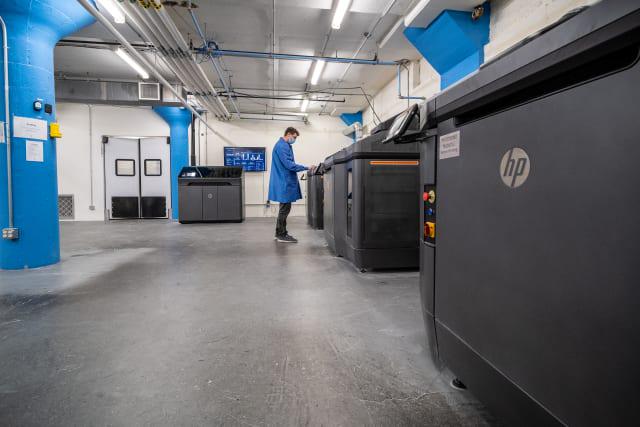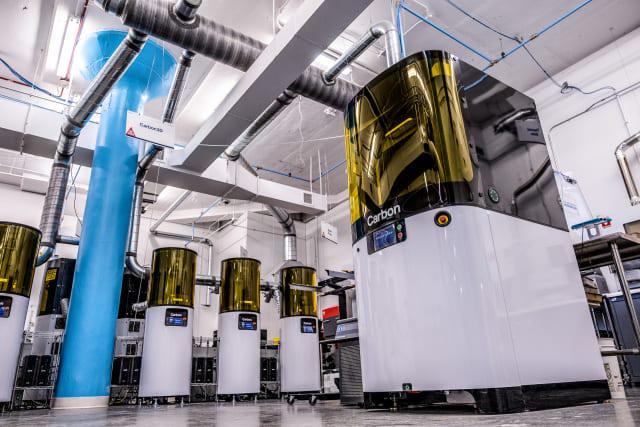
by Staff, Jun 28, 2021
Collected at: https://www.engineering.com/story/what-is-a-micro-factory-and-how-will-it-transform-manufacturing?utm_source=engineering.com&utm_campaign=08704fc5e3-EMAIL_CAMPAIGN_7_12_2018_8_42_COPY_01&utm_medium=email&utm_term=0_622b2cc90f-08704fc5e3-323001813
Fast Radius has submitted this post.
By John Nanry, co-founder and chief manufacturing officer, Fast Radius
Imagine you could print a part on demand anywhere in the world, without any variation in quality. The part would be exactly the same whether it was printed in Chicago or Singapore.
The benefits would be enormous. You would slash your shipping costs and your carbon footprint, while making your business more agile and your supply chain more resilient. If a natural disaster, pandemic or other emergency affected factories in one region, you could shift production to a different region with barely more than the click of a button.

HP MJF micro-factory. (Image courtesy of Fast Radius.)
That’s the promise of a micro-factory—a “factory in a box” designed to be copy-and-pasted to create identical facilities around the globe. But the word “micro” is a bit deceptive: these are professional facilities capable of manufacturing full runs of production-ready parts. All the production processes involved are digital, with software controlling all the hardware.
When integrated with a cloud manufacturing platform, micro-factories offer engineers scalable, on-demand access to parts manufacturing along with real-time insights and intelligence at every step of the manufacturing lifecycle. A global network of these interconnected facilities has the capability to transform manufacturing as we know it.
A Micro-Factory Has Highly Standardized Physical and Digital Infrastructure
The physical and digital infrastructure of micro-factories forms the foundation of a cloud manufacturing platform. In the same way that server farms operated by Microsoft Azure or Amazon Web Services support an entire ecosystem of infrastructure and applications, micro-factories support software and hardware components that deliver various solutions to internal stakeholders and clients. Tight integration of digital and physical infrastructure is the future of manufacturing—and the micro-factory model relies on it.

Carbon micro-factory. (Image courtesy of Fast Radius.)
Physical Infrastructure
Micro-factories can range in size from as small as a few thousand square feet to as large as a traditional factory. Each one focuses on a particular production technique, including both conventional manufacturing processes such as CNC machining, and additive technologies such as Carbon Digital Light Synthesis (DLS), HP Multi Jet Fusion (MJF), Stratasys Fused Deposition Modeling (FDM) and Formlabs Stereolithography (SLA).
Each micro-factory contains equipment for all stages of production, from pre-processing to quality control. To ensure reliability and repeatability across locations, each micro-factory must control for hundreds of variables. Everything is standardized, from floor plans and workflows to environmental variables like temperature and humidity. Industry 4.0 sensors ingest data across end-to-end factory processes, supporting a high level of transparency.
Digital infrastructure
Layered on top of a micro-factory’s physical infrastructure is a software layer that controls operations within the facility and connects the micro-factory to a broader cloud manufacturing platform. Within each micro-factory, the data collected by Industry 4.0 sensors enables real-time order status updates as well as other factory management functions such as predictive maintenance monitoring and machine monitoring. Network management features such as control tower order management, production scheduling and capacity load analysis enable efficient workflows.
The build package for each part includes detailed design and production specifications to ensure consistent execution of each order. These specifications can be stored in a virtual warehouse and manufactured on demand at any micro-factory in the network with the necessary production capabilities. An operating system layer enables orchestration of operations across all micro-factories, while another layer of the cloud manufacturing platform, the learning engine, analyzes data collected in each micro-factory to continuously optimize parts design and factory operations.
Micro-Factories Boost Efficiency, Agility and Sustainability While Reducing Costs
The micro-factory model has a few key benefits that Fast Radius customers already enjoy today. Internally, the micro-factory model helps Fast Radius be more agile by enabling us to take on very small orders to fill our capacity when needed, while also maintaining the infrastructure necessary to handle entire production runs.
Externally, our micro-factories enable us to act as an accelerator for innovative customers. If you love to move fast, we can help you move faster. We do low-volume production (i.e., prototyping) on the same equipment we do high-volume production. This ensures consistency and makes it easy to scale when you’re ready to ramp up from prototyping to production.
Today, Fast Radius has micro-factories specializing in CNC, MJF, DLS, SLA and FDM across three sites, with plans to grow in the coming years. A high level of standardization makes the model easy to scale.

Stratasys micro-factory. (Image courtesy of Fast Radius.)
As our global network of micro-factories expands and we are able to print parts at facilities around the world, we’ll unlock additional benefits.
- Cost reduction: Transportation costs can account for a large percentage of the cost of a particular part. By manufacturing a part close to where it is needed, you can dramatically reduce costs—on top of cost savings already delivered by the efficiency of micro-factory production.
- Supply chain sustainability: Transporting a part over long distances greatly expands its carbon footprint, thanks to vehicle emissions. So, manufacturing parts closer to where they are needed reduces environmental impact, too.
- Flexible capacity: Having a global network of micro-factories at your disposal makes it easy to scale production up or down fast. Need to meet a sudden spike in demand? Expand production to additional facilities with identical infrastructure, anywhere in the world.
The Future of Micro-Factories
As micro-factories spread around the world, they will promulgate a standard way of working and operating that will create global production unity. Today, cloud computing giants like AWS and Azure provide standardized platforms on which a wide diversity of services and applications can run. In the near future, we’ll see similar consolidation in cloud manufacturing, with a few companies providing standardized micro-factories that handle most modern manufacturing production. At Fast Radius, we’re excited for our micro-factories to lead the way toward this more connected, efficient and sustainable future.
Learn more about Fast Radius and how our team is transforming the manufacturing industry at fastradius.com/yes.
